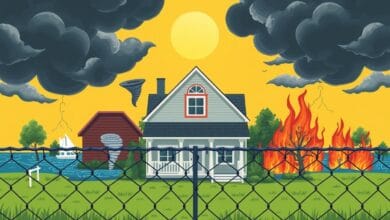The Difference Between Homeowners and Landlord Insurance

Did you know landlord insurance is 25% pricier than standard homeowners insurance? This big price difference shows the unique risks and special coverage needed for rental properties. Homeowners and landlord policies differ in how they handle occupancy, property, liability, and loss of use versus loss of rent.
It’s key for property owners to know the differences between these two insurance types. Whether you live in your home or rent it out, understanding these differences is crucial. In this article, we’ll dive into the details of homeowners and landlord insurance. This will help you choose the right coverage for your needs.
Key Takeaways
- Landlord insurance is typically more expensive than homeowners insurance due to the unique risks associated with renting out properties.
- Homeowners insurance may not provide adequate coverage for short-term rentals, prompting the need for specific coverage or landlord insurance.
- Landlord insurance is crucial when renting out properties for long-term stays, especially when the premises are not occupied by the landlord.
- Landlord insurance provides specialized protections, such as rental compensation and liability coverage, that justify the higher cost compared to homeowners insurance.
- Failure to obtain the correct insurance coverage when renting out properties can result in significant financial liabilities.
Understanding Homeowners Insurance
Homeowners insurance is a policy that protects homes where the owners live. It’s different from landlord insurance, which covers rental properties. Homeowners insurance has many coverage options to meet the needs of homeowners.
What is Homeowners Insurance?
Homeowners insurance is a contract that covers almost everything except what’s excluded. It protects against damage from fire, wind, rain, lightning, vandalism, and accidental water damage.
Coverage of Homeowners Insurance
It also covers the policyholder’s personal property, like furniture, jewelry, and other household items. Plus, it includes loss of use coverage. This helps pay for temporary living costs if the home is not safe to live in due to damage.
Having homeowners insurance is key to protecting your home and belongings. It also covers you if someone gets hurt or damages your property.
“Homeowners insurance is a crucial investment for any homeowner, offering comprehensive protection for your most valuable asset.”
Understanding Landlord Insurance
Landlord insurance is made for those who rent out properties. It’s different from regular homeowners insurance. It covers the building, any extra buildings, and can help if you can’t rent out your property because of damage.
What is Landlord Insurance?
Landlord insurance is a special kind of insurance for those who rent out properties. It protects the building and can help if you can’t rent it out because of damage. It’s important for landlords to have this to protect their money and property.
Types of Landlord Insurance Policies
There are three main types of landlord insurance policies:
- DP-1 (Basic Coverage): This policy covers the property against named perils like fire, lightning, and windstorm.
- DP-2 (Broader Coverage): This policy covers more, including theft, vandalism, and some water damage.
- DP-3 (Comprehensive Coverage): This policy covers all risks of physical loss or damage, except for what’s excluded.
The right policy depends on how much protection and risk management the landlord needs.
| Policy Type | Coverage | Typical Cost |
|---|---|---|
| DP-1 (Basic Coverage) | Named perils (fire, lightning, windstorm) | $500 – $800 per year |
| DP-2 (Broader Coverage) | Wider range of perils (theft, vandalism, some water damage) | $800 – $1,200 per year |
| DP-3 (Comprehensive Coverage) | All risks of physical loss or damage, except exclusions | $1,200 – $1,800 per year |
The choice of policy depends on the owner’s needs, risk level, property location, and condition.
Homeowners and Landlord Insurance
Homeowners and landlords have different needs when it comes to property insurance. Homeowners insurance is for homes where the owners live. On the other hand, landlord insurance is for tenant-occupied rental properties.
Landlord insurance covers accidents on the rental property, like slips and falls. It also protects against injuries to visitors. Homeowners insurance protects the policyholders and their family, even when they’re not at home.
Landlord insurance also covers wrongful eviction claims and damage from vandalism, water, falling objects, and fire. This is especially important in places like California.
| Homeowners Insurance | Landlord Insurance |
|---|---|
| Designed for owner-occupied residences | Tailored for tenant-occupied rental properties |
| Covers personal liability for policyholders and household members | Covers liability for accidents on the rental property |
| Includes coverage for personal property within the home | May not cover personal property, unless it is used to maintain the property |
| May provide limited coverage if the home is temporarily rented out | Offers rental income protection in case the property becomes uninhabitable or a tenant moves out |
Homeowners insurance is usually cheaper. But landlord insurance is 15%-20% more expensive because of the risks of renting. Still, landlord insurance is key for protecting investments.
“It is recommended for landlords to periodically review their insurance coverage to ensure they are adequately insured.”
In summary, the choice between homeowners insurance and landlord insurance depends on the property’s use and the owner’s needs. Knowing the differences helps owners protect their investments and avoid risks.
Occupancy: The Key Difference
The main difference between homeowners and landlord insurance is the property’s occupancy. Homeowners insurance is for owner-occupied properties, where the owner lives there. On the other hand, landlord insurance is for tenant-occupied properties, where the owner rents it out.
This difference is key because tenant-occupied properties are riskier for insurers. Homeowners who rent out their homes might become “accidental landlords.” This can leave them without the right coverage if they only have a homeowners policy.
Owner-Occupied vs Tenant-Occupied Properties
The main difference between owner-occupied and tenant-occupied properties is the risk they pose. Owner-occupied homes usually have fewer claims and lower claim amounts. This affects the insurance costs.
| Property Type | Average Claim Amount | Claim Frequency | Insurance Costs |
|---|---|---|---|
| Owner-Occupied | Lower | Fewer | Lower |
| Tenant-Occupied | Higher | More Frequent | Higher |
Tenant-occupied properties often need special coverage, like for lost rental income and more liability. This is not covered by a standard homeowners policy.
“Landlord insurance policies typically offer more liability coverage than standard homeowners insurance policies, which contributes to higher costs.”
Property Coverage Comparison
When it comes to property coverage, both homeowners property coverage and landlord property coverage protect the physical structure. This includes the building, fixtures, and outbuildings. However, there are key differences in personal property coverage.
Homeowners insurance covers the policyholder’s personal items like furniture and electronics. On the other hand, landlord insurance doesn’t cover the tenants’ personal belongings. It mainly protects the rental property’s structure, any landlord-provided appliances, and dwelling coverage.
| Coverage Type | Homeowners Insurance | Landlord Insurance |
|---|---|---|
| Building and Structures | ✓ | ✓ |
| Personal Property | ✓ | ✘ |
| Landlord-Provided Appliances | ✘ | ✓ |
| Loss of Rental Income | ✘ | ✓ |
Homeowners and landlords should review their insurance policies carefully. This ensures they have the right coverage for their needs and property use. Knowing the differences between homeowners property coverage and landlord property coverage helps make informed decisions. This protects investments and reduces risks.
Liability Protection: Homeowners vs Landlords
Homeowners and landlords both have insurance that protects them from liability. This coverage helps pay for legal and medical costs if someone gets hurt on the property. It’s very important for places with dangers like pools or trampolines.
Personal Liability Coverage
Homeowner liability coverage and landlord liability coverage are similar but different. Landlords might need to get more personal liability protection because of the risks with tenants. Tenants who rent for short times might not take care of the place well, leading to big problems and higher insurance costs.
| Homeowner Liability Coverage | Landlord Liability Coverage |
|---|---|
| Covers injuries to guests on the property | Covers injuries to tenants and their guests on the property |
| Protects the homeowner from legal and medical expenses | Protects the landlord from legal and medical expenses related to tenant injuries |
| Typically has lower liability limits | Often requires higher liability limits to account for increased risk |
Knowing the differences between homeowner liability coverage and landlord liability coverage helps property owners. They can make sure they have the right personal liability protection. This protects their investment and reduces risks.
Pricing and Cost Factors
Landlord insurance usually costs about 25% more than regular homeowners insurance cost. This is because rental properties face more risks. These risks include more wear and tear, liability issues, and the chance of losing rental landlord insurance cost income.
Several factors can change the cost of landlord insurance. These include the property’s location, the building’s age and condition, and the landlord’s claims history. Also, the level of coverage chosen matters. Risk factors for rental properties like natural disasters, crime rates, and local laws can also affect insurance costs in different areas.
| Coverage Type | Average Annual Cost |
|---|---|
| Dwelling Coverage | $2,200 |
| Contents Coverage | $35 |
| Vandalism Coverage | $532 |
| Liability Coverage | $350 |
In California, the average landlord pays about $1,700 a year for insurance. This is 20-30% more than the national average for homeowners insurance cost. The size of the property, the building’s age and condition, and the type of tenants can also affect the cost.
To lower insurance costs, landlords can install safety features like smoke detectors and proper lighting. This might help reduce the landlord insurance cost. Some insurers also offer discounts for landlords who meet certain criteria, like using specific locks or smoke detectors in their rentals.
Loss of Use vs Loss of Rent Coverage
Homeowners and landlords have different needs for property insurance. Homeowners insurance often includes loss of use coverage. This helps pay for temporary living costs if a home is not livable due to damage. Landlord insurance, on the other hand, offers loss of rent coverage. It protects a landlord’s income if a property is not ready for tenants.
Loss of use coverage in homeowners insurance can be 10% to 20% of the home’s value. For example, with a $200,000 home, coverage could be $20,000 to $40,000. Condo insurance might cover up to 20% of the home and personal items. Renters insurance might offer a flat amount or a percentage of personal items.
For landlords, loss of rent coverage is key to avoid financial loss. This coverage helps pay for lost income when a property is not ready for tenants. It usually covers the cost of repairs or until tenants return, up to a year.
“Landlord insurance can help protect homeowners from financial hardship if their property is damaged or destroyed.”
Landlords need enough loss of rent coverage to cover ongoing costs like mortgage payments. But, this coverage doesn’t help with unpaid rent or legal issues with tenants.
In short, homeowners insurance covers temporary living costs, while landlord insurance protects rental income. Knowing the difference helps both homeowners and landlords get the right insurance for their needs.
Conclusion
The main differences between homeowners and landlord insurance are about who lives in the property and what it covers. Homeowners insurance is for those who live in the property themselves. On the other hand, landlord insurance is for properties rented out to tenants. Knowing these differences helps property owners pick the right insurance to protect their investments and financial interests.
When deciding between homeowners vs. landlord insurance, property owners need to think about their property’s specific needs and risks. Landlord insurance covers lost rental income, damages caused by tenants, and other risks not covered by homeowners insurance. Homeowners insurance, however, offers more protection for personal items and living costs if the property is damaged or needs to be temporarily moved.
Understanding the differences between these insurance options helps property owners protect their investments. This knowledge is key to keeping a successful and stable real estate portfolio.
FAQ
What is the purpose of homeowners and landlord insurance?
Homeowners insurance protects the home and belongings from disasters. It also offers liability protection. Landlord insurance, however, is made for landlords. It covers income and property from tenant damages, disasters, and liability claims.
What are the key differences between homeowners and landlord insurance?
Homeowners insurance is for homes where the owner lives. Landlord insurance is for rental properties. This means different coverage, prices, and risks for each type of property.
What does homeowners insurance typically cover?
Homeowners insurance covers almost any damage not listed as excluded. It includes fire, wind, and vandalism. It also covers personal property and temporary living expenses if needed.
What are the main types of landlord insurance policies?
There are three main types of landlord insurance: DP-1, DP-2, and DP-3. DP-1 is basic, DP-2 is broader, and DP-3 is comprehensive. The choice depends on the landlord’s protection needs.
How does liability coverage differ between homeowners and landlord insurance?
Both types of insurance have personal liability coverage. This protects against legal and medical costs if someone is hurt on the property. Landlords might need higher liability limits due to higher risks.
Why is landlord insurance typically more expensive than homeowners insurance?
Landlord insurance is about 25% more expensive. This is because rental properties face more risks like wear and tear, liability, and loss of rent.
What is the difference between loss of use coverage and loss of rent coverage?
Homeowners insurance covers temporary living expenses if the home is damaged. Landlord insurance, however, covers lost rent if the property is uninhabitable and the tenant moves out.


